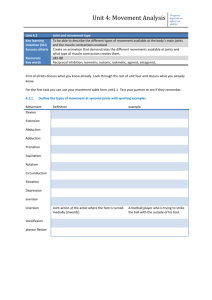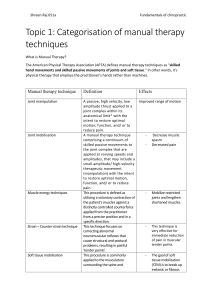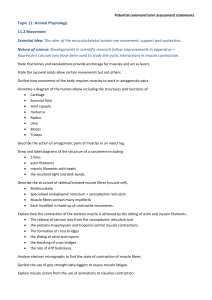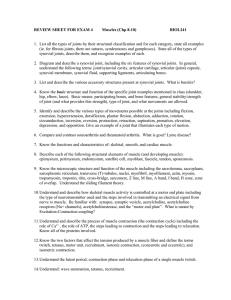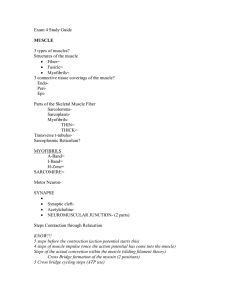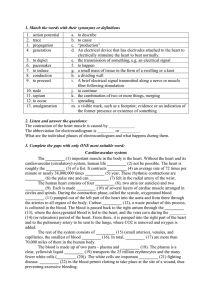Study guidelines: 3rd. test. BIOL 2651
advertisement
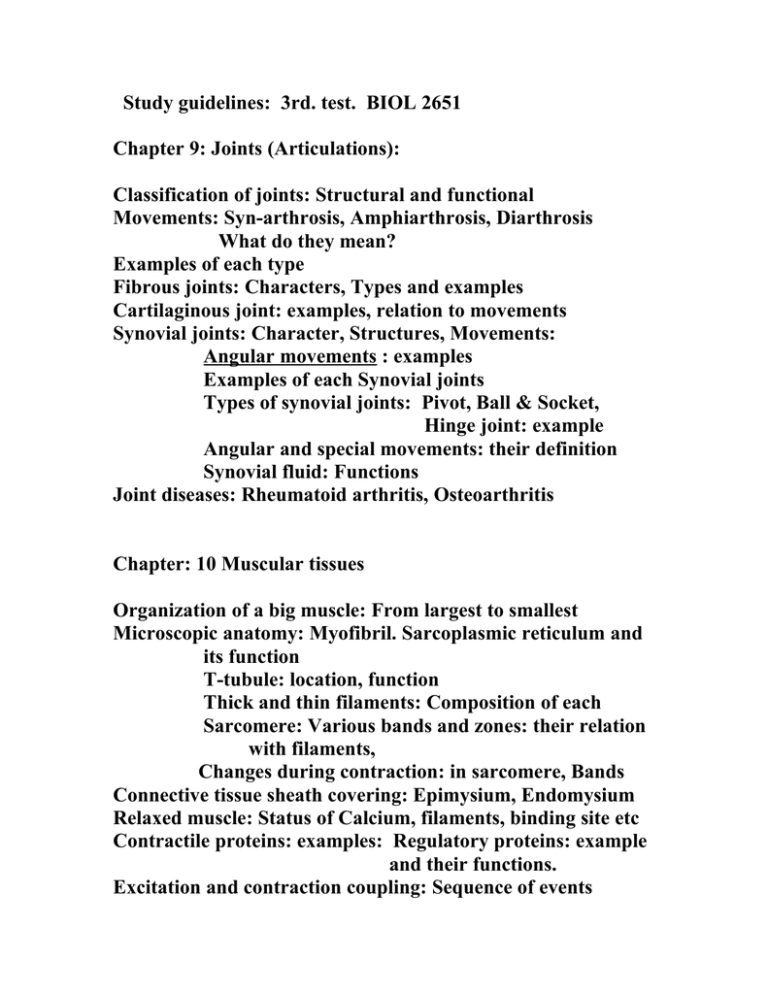
Study guidelines: 3rd. test. BIOL 2651 Chapter 9: Joints (Articulations): Classification of joints: Structural and functional Movements: Syn-arthrosis, Amphiarthrosis, Diarthrosis What do they mean? Examples of each type Fibrous joints: Characters, Types and examples Cartilaginous joint: examples, relation to movements Synovial joints: Character, Structures, Movements: Angular movements : examples Examples of each Synovial joints Types of synovial joints: Pivot, Ball & Socket, Hinge joint: example Angular and special movements: their definition Synovial fluid: Functions Joint diseases: Rheumatoid arthritis, Osteoarthritis Chapter: 10 Muscular tissues Organization of a big muscle: From largest to smallest Microscopic anatomy: Myofibril. Sarcoplasmic reticulum and its function T-tubule: location, function Thick and thin filaments: Composition of each Sarcomere: Various bands and zones: their relation with filaments, Changes during contraction: in sarcomere, Bands Connective tissue sheath covering: Epimysium, Endomysium Relaxed muscle: Status of Calcium, filaments, binding site etc Contractile proteins: examples: Regulatory proteins: example and their functions. Excitation and contraction coupling: Sequence of events Contraction cycle: stages (4) Troponin C and Calcium: troponin-tropomyosin complex leads to Exposure of myosin head binding site on actin Neuro-muscular junction (NMJ): structure, motor-end plate, Synaptic end bulb: Location Neuromuscular transmission: Events One way transmission, with the release of acetylcholine Summation and tetanus: Found only in skeletal muscle. Their definition Types of skeletal muscle contractions: Isotonic. Isometric Cardiac muscle: Characters, Why no summation: long refractory period Smooth muscle: Difference in contraction from skeletal & its location. Calcium combines with Calmodulin and not with Troponin C Chapter 11: Muscular system: Muscle origin and insertion; Definition and example Fascicle & tendon arrangement: Examp: Deltoid, Pectoralis Major, Rectus Femoris etc Coordination amongst muscles: Agonist, Synergist, Antagonist: Definition of each with examples Muscles: Temporalis, Masseter, Ant. Tibial, Biceps femoris Trapezius, Rectus abdominis, Orbicularis oculi, Deltoid, Triceps brachii: Location and action of each Muscle acts on: Mandible (chewing), Humerus , Abdominal wall, Eye, pectoral girdle, breathing, facial expression, breathing etc Chapter 12: Nervous Tissue: Over view of NS (classification): CNS & PNS Components of CNS & PNS Brain and its components: cerebrum, cerebellum, Brain-stem, and diencephalon Division of PNS: SNS, ANS & ENS Neurons: Structure and types, neuroglial cells: types Gray and white matter: composition Ion channels: gated channels: Types (3) Example of each. Voltage gated ion channel Neuroglial cells: Types and their functions Myelination: Schwaan cells & Oligodendrocytes. Rate of conduction : faster in myelinated nerves Spinal nerves: Number, components, belongs to PNS Cranial nerves: number, Belongs to PNS Graded and action potential: Characters & differences Graded Potential: localized, graded, can lead to depolarization or hyper polarization of post-synaptic mem. Action Potential: depolarization is followed by Repolarization How they are produced? What causes deporization and Repolarization? Summation : types (2)Special & temporal EPSP & IPSP: Characters, events, Changes in the postSynaptic membrane (Partial deporization, Excitable potential, Cell become more excitable when RMP changes from -70 mv to – 50 mv)

